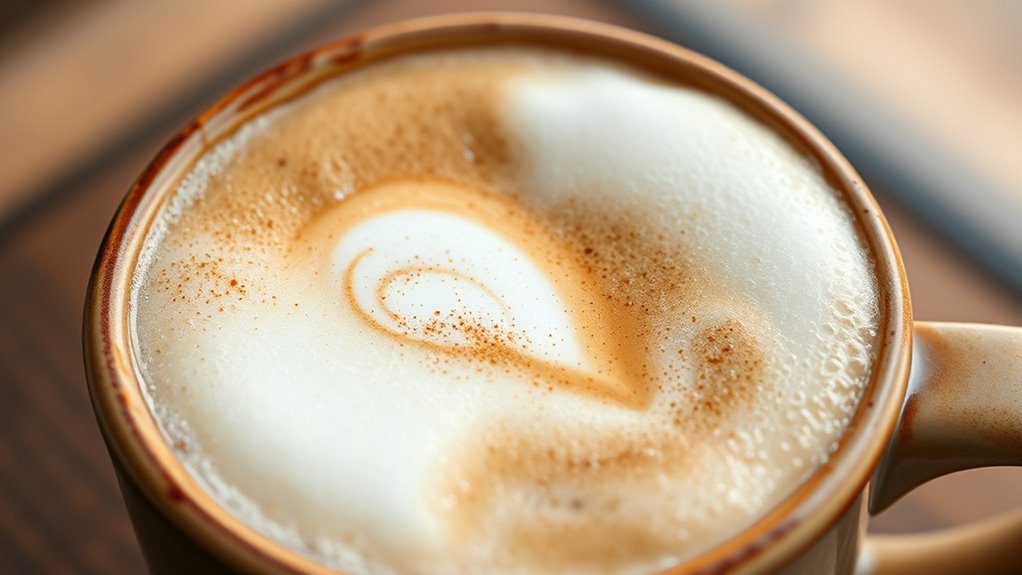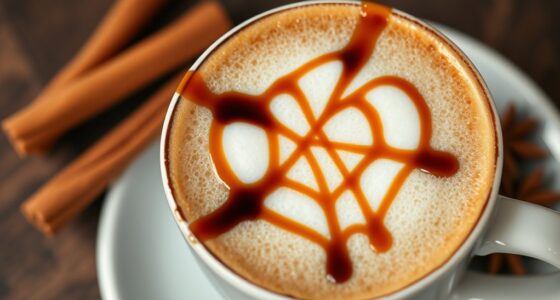To balance flavor and safety, aim for your cappuccino milk to reach between 140°F and 150°F (60°C to 65°C). This temperature guarantees the milk develops a sweet, rich taste without burning or losing freshness. Proper heating creates smooth microfoam that blends seamlessly with espresso, enhancing both texture and appearance. Maintaining this ideal range preserves flavor integrity and prevents scalding. If you want to discover more about perfecting your cappuccino’s temperature, keep exploring the details below.
Key Takeaways
- Maintain milk temperature between 140°F to 150°F (60°C to 65°C) for optimal flavor and microfoam quality.
- Proper temperature prevents milk from scalding, preserving sweetness and avoiding burnt tastes.
- Use a thermometer or machine controls to ensure precise heating and consistent results.
- Properly heated milk creates a smooth, velvety foam that enhances cappuccino texture and presentation.
- Avoid overheating to reduce safety risks and preserve the beverage’s flavor balance.

A perfect cappuccino balances rich flavor with a smooth, velvety texture, and achieving that starts with serving it at the right temperature. When it comes to creating an ideal cappuccino, milk frothing plays an essential role. You want the milk to reach the right temperature so that it can be frothed to perfection, producing that airy, creamy foam that complements the espresso beautifully. Proper milk frothing isn’t just about creating foam; it’s about controlling the temperature to guarantee the milk doesn’t get too hot or too cold. If the milk overheats, it loses its sweetness and can develop a burnt taste, ruining the balance you’re aiming for. Conversely, if it’s too cold, the foam won’t have the right consistency, and the cappuccino won’t have that inviting, silky feel.
Temperature control during milk frothing is key. Ideally, you want the milk to reach around 140°F to 150°F (60°C to 65°C). At this point, the milk is hot enough to develop a sweet, rich flavor without risking scalding. Using a thermometer helps you keep this process precise, especially if you’re manually steaming milk. Many espresso machines come with built-in temperature controls, which make it easier to maintain the perfect heat. Once you hit that temperature window, you should hear a gentle hissing or a slight whistle from the steam wand, indicating that the milk is steaming correctly. You don’t want to over-pressurize or overheat the milk, as it can lead to a burnt flavor or a skin forming on the surface, both of which compromise taste and texture.
Mastering milk frothing with proper temperature control also affects the final presentation of your cappuccino. When the milk is textured at the right temperature, it integrates seamlessly with the espresso, creating that ideal layered look with a glossy, dense foam on top. This foam should be smooth and velvety, not bubbly or frothy, which is a sign that you’ve over- or under-frothed. Ensuring consistent temperature control during the frothing process allows you to produce that luxurious microfoam that’s essential for a balanced cappuccino. Remember, too, that pouring the milk at the right temperature ensures the flavor remains vibrant and well-rounded, preventing any bitterness or dullness caused by improper heating.
Additionally, understanding how AI safety measures impact the development of reliable and safe AI systems can be crucial for future technological advancements, including those that could influence coffee-making tools or automation.
In the end, paying close attention to milk frothing techniques and temperature control helps you craft a cappuccino that’s not just visually appealing but also bursting with flavor and satisfying texture. It’s a simple step that makes a significant difference in elevating your coffee experience, turning a good cup into an exceptional one.
Frequently Asked Questions
How Does Milk Temperature Affect Cappuccino Foam Quality?
You’ll notice that milk temperature directly impacts your cappuccino foam quality. When milk is steamed too hot, it can create overly airy, unstable froth, reducing foam stability. Conversely, if it’s too cold, the milk won’t froth well, resulting in poor milk froth and weak foam. For perfect foam stability and luscious milk froth, aim for a temperature around 150°F (65°C). This balance guarantees rich flavor and ideal foam consistency.
Can Drinking Hot Cappuccino Cause Burns?
Yes, drinking hot cappuccino can cause burns if the beverage is too hot. The burn risk increases with very hot beverages, especially if you’re not careful or if the drink spills. To avoid burns, let your cappuccino cool slightly before sipping. Always test the temperature first, and handle your cup carefully. Remember, hot beverages pose a burn risk, so enjoy your drink responsibly to prevent accidents.
What Is the Ideal Temperature for Storing Milk?
You should store milk at or below 40°F (4°C) to guarantee proper milk preservation and meet refrigeration standards. Keeping it at this temperature slows bacterial growth, maintaining freshness and safety. Always check your refrigerator’s temperature regularly, and store milk in the coldest part of the fridge, preferably in a sealed container. Proper storage helps extend milk’s shelf life and prevents spoilage, ensuring it stays safe and fresh for your use.
How Quickly Does Cappuccino Cool Down to a Safe Temperature?
Your cappuccino cools down to a safe temperature in about 10 to 15 minutes, depending on the initial temperature and the environment. The temperature retention of your drink influences the cooling rate; a hotter cappuccino loses heat faster initially but then slows as it approaches room temperature. To enjoy it safely, drink within this timeframe or reheat if it cools too much.
Does Temperature Impact the Caffeine Taste in Cappuccino?
Imagine sipping a hot cappuccino, and you notice a duller caffeine taste as it cools. Temperature directly impacts caffeine extraction; higher temps boost extraction, making caffeine more potent, while cooler drinks diminish it. This affects flavor preservation, so drinking at the right temperature ensures you enjoy the full caffeine profile. If it cools too much, you might miss out on that rich, robust taste you’re after.
Conclusion
Remember, the perfect cappuccino is like a well-choreographed dance—balancing flavor and safety in harmony. Keep your drink around 150°F to 155°F, and you’ll enjoy its rich, creamy goodness without burning your tongue. Don’t rush the process; patience is your best barista. When you hit that sweet spot, every sip becomes a cozy hug in a mug. So, savor the warmth and let your taste buds thank you for the perfect brew.









